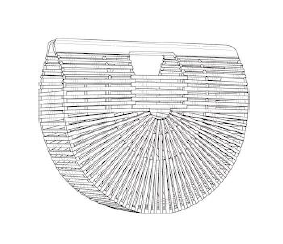In a recent precedential1 opinion, the U.S. Patent and Trademark Office’s Trademark Trial and Appeal Board affirmed the refusal to register Jasmin Larian, LLC’s handbag design mark for “handbags” in Class 18, on the grounds that the mark is either generic or comprises a nondistinctive product design under Sections 1, 2, and 4 of the Trademark Act. See In re Jasmin Larian, LLC, Serial No. 87522459 (January 19, 2022).
The case sheds light on the difficulty of protecting product configuration marks – a form of trade dress that covers the non-functional aspects of product design – versus more typical word and logo marks. It is usually easier to obtain trade dress protection for product packaging versus product design, because consumers are less likely to view product design as a source identifier.
One challenge in protecting product configuration is that designs that are functional are never registrable as product configuration trade dress. In general terms, a feature is “functional” and cannot serve as a trademark if it is (1) essential to the use or purpose of the article, or (2) if it affects the cost or quality of the article.
Additionally, unlike other forms of trade dress, product design trade dress is never considered inherently distinctive, and is protectable only upon a showing that the design has acquired secondary meaning.
Whether a mark has acquired distinctiveness is determined by weighing the following factors:
1. Association with a particular source by actual purchasers;
2. Length, degree, and exclusivity of use;
3. Amount and manner of advertising;
4. Amount of sales and number of customers;
5. Intentional copying; and
6. Unsolicited media coverage of the product embodying the mark.
Here are some key takeaways from the Jasmin Larian case to ensure your product configuration is entitled to trade dress protection.
1. Make sure you are the ONLY seller of a product bearing the configuration trade dress.
In the subject case, Applicant began selling the handbag design in 2013. At the time, numerous entities already sold handbags bearing similar designs, and these entities continued to sell similar bags throughout the application prosecution. The TTAB found the concurrent use weighed in favor of finding the design mark generic and non-distinctive.
2. If possible, be the first to sell the product bearing the configuration trade dress.
Evidence put forth in this case demonstrated that the design Applicant sought to protect had been sold by third parties since at least the 1940’s, coming in and out of popularity within the fashion industry. The TTAB noted that though it is not a requirement that the brand owner be first in the market with a particular design, it is much easier to demonstrate that consumers associate the design with the applicant when the applicant is the one that introduces the design.
3. Market your product configuration as a trademark.
Applicant described the handbag as “a reproduction of a classic Japanese picnic bag” on its website. Further, when purchasers received the handbag, it included an informational card that said “This CULT GAIA bamboo handbag is a reproduction of a classic Japanese picnic bag.” These statements undermined claims that the product configuration was associated with Applicant.
4. Police your product configuration mark and demand recognition of the product configuration mark as a trademark.
As Applicant’s handbag grew in popularity, other third parties sold similar handbags. While Applicant was successful in policing such use, the issue is that the third parties also used word marks and proprietary photographs. Therefore, while these cease and desist letters were effective, it was not clear that they were effective because the third parties recognized the rights in the product configuration mark, versus the other IP claimed by Applicant.
While demonstrating the difficulties of protecting product configuration marks, the Jasmin Larian case also provided guidance on effective strategies to ensure your product configuration mark receives protection in the future.
[1] The opinion originally issued as non-precedential but was later redesignated as precedential.
This article appeared in the July 2022 issue of MarkIt to Market®. To view our past issues, as well as other firm newsletters, please click here.
Related Industries

Receive insights from the most respected practitioners of IP law, straight to your inbox.
Subscribe for Updates
